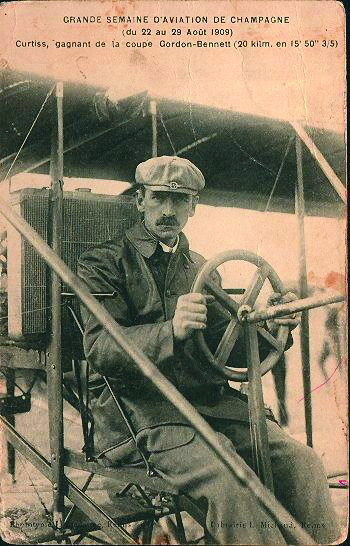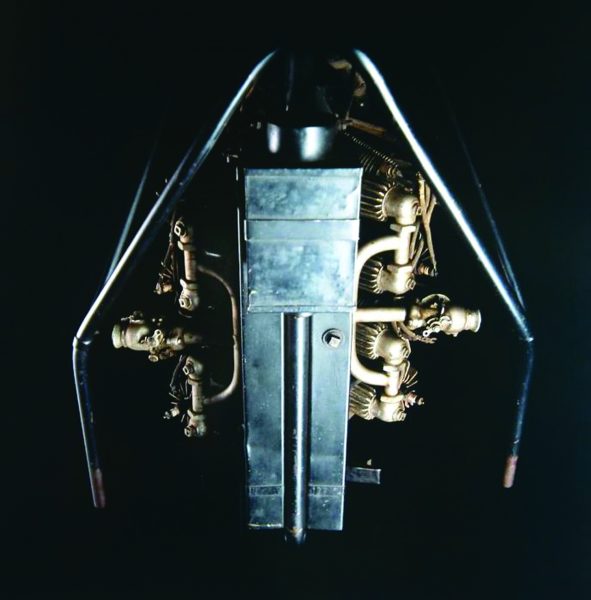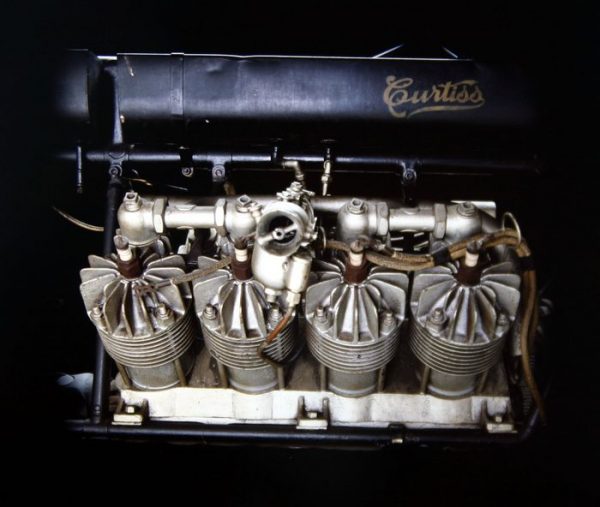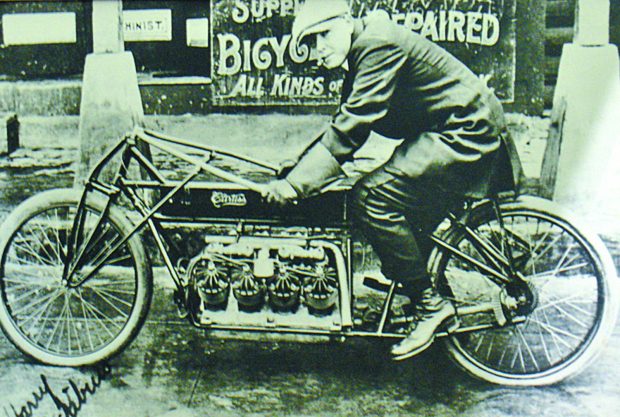THE FASTEST MAN IN THE WORLD … GLEN H. CURTISS
An American Hero Slips the Surly Bonds of Earth: Glenn H. Curtiss
By Paul Garson
Photography courtesy of the Smithsonian Air and Space Museum, The Glenn H, Curtiss Museum, Roy Kidney and Jack Carpenter
“The fastest man in the world … bullets are the only rivals of Glenn H. Curtiss of Hammondsport.” – 1907 newspaper headline
Wearing a leather cap, a well-manicured, and a steely gaze, Glenn Hammond Curtiss stares out of a time-worn black and white postcard-like photo. In the background, frothy waves splash the beach, the very hard packed sands upon which his experimental V-8 powered motorcycle will transport him into the history books as “The Fastest Man in the World.” The day was Thursday, January 24, the year 1907 and the place, Ormond Beach on the east coast of Florida. The record … 136.3 mph, a land speed record that would stand for 11 years and then only surpassed by an automobile—the Blitzen Benz hitting 141 mph. It would not be until 1930 that a motorcycle would best Glenn Curtiss’s feat of daring-do and mechanical design.

The surfside setting for the famous blast down the beach had its origins a few years earlier when in 1902 influential Ormond Beach residents began promoting racing on the local beach with an inaugural automobile speed run. The sport grew in popularity and even Henry Ford showed up for an event in one of his early cars and slept in it. At the time, he couldn’t afford a hotel room. Another “celebrity” to take up residence in Ormond Beach was John D. Rockefeller. Rockefeller wanted to live to 100 and was looking for the perfect healthy environment in order to reach the century mark (he made it to 97). Ormond Beach became a playground for the rich and famous … and those feeling the need for speed. Case in point, one Glenn H. Curtiss, a true American hero and a larger than life personality whose exploits inspired a popular series of youth books “The Adventures of Tom Swift” penned by Victor Appleton. And yes, there was one volume circa 1910 titled “Tom Swift and His Motor-Cycle or Fun and Adventures on the Road.”

Curtiss was always looking for new adventures on, or off, the road. He knew he could find the fast lane he needed to break the existing record at Ormond Beach. It was at Ormond Beach in 1904 where Charles Schmidt drove his Packard Gray Wolf to a world record in the kilometer at 76 mph and where, William Vanderbilt, Jr. set the world record for the one-mile, reaching 92 mph in a 90-horsepower Mercedes. These races put Ormond Beach on the speed map and brought it fame as home to 30 years of land-speed records eventually evolving into the now famous Daytona Beach 500 and the founding of NASCAR.
Back in 1907, the 29-year old Glenn Curtiss had already invented or developed many of the more than 500 designs and components he would use during his lifetime. He had a hand in the development of the Wright Brothers first airplane and additional aeronautical experiments. He also partnered with Alexander Graham Bell that included developing and patenting the aircraft aileron now universally intrinsic to controlled flight.

Whether it was propeller powered or rolled on wheels, Glenn was always pushing the envelope. Although his lasting fame would rest with aircraft, it all began with motorcycles. As a result of his experiences as a bicycle racer, Western Union bicycle messenger and bicycle shop owner Curtis became interested in motorcycles. In 1901, he began motorizing bicycles with his own single cylinder internal combustion engines, initially fashioned from tomato cans. He not only talked the talk, he walked the walk, racing what he built and earning the accolade in 1903 as the “First American Motorcycle Champion” by reaching 54.6 mph. By 1905, he set the world speed records for one, two, and three-mile events. Aside from piloting his speedsters, he tinkered out a number of advancements including the handlebar twist grip throttle control and a triple cylinder engine designated the W-3, essentially a V-twin with a third cylinder which Curtiss himself called the fastest production motorcycle in the world.
How such ingenuity arose is one of those mysteries of nature for Curtiss was raised in near poverty and lost his parents when very young and subsequently only attained an 8th-grade education. As Trafford Doherty, Director of the Curtiss Museum explains, “Curtiss was incredibly intuitive and incredibly mechanical. He was also extremely athletic and in the1890s was virtually unbeaten as a bicycle racer. He was very competitive, and that competitive nature appeared first with bicycles, then motorcycles, and then with his business ventures. While of a serious demeanor, a man of relatively few words and not comfortable with public speaking, he was also known to be congenial among his fellows. His contributions were legion and rightly earned him the accolades as “The Henry Ford of Aviation” and “The Fastest Man in the World.”
On a cool overcast day in 1907, Glenn Curtis made his mark, at least in the history books of motorcycling. He had been designing and building a variety of engines including singles, V-twins and inline fours, but he literally made his mark with a lightweight air-cooled V8. The power plant came into existence due to the ever-increasing demand for more powerful aircraft engines for the burgeoning production of early 20th century flying machines. The record-breaking motorcycle itself was basically a rolling, but not quite flying, test-bed for the new Curtiss 40 hp “monster” motor.

The configuration was based on a very square 3.25 x 3.25-inch bore and stroke that displaced a potent 269 cubic inches. While his preceding engines were primarily single cylinder and 50-degree V-Twins, Curtis went to a 90-degree design featuring cast iron F-type heads, as utilized on his smaller displacement power plants. Moreover, it dispensed with head gaskets, thanks to the quality of its design and manufacture. Inside the massive hunk of metal lurked a solid billet steel crank while internal lubrication was handled via a dry sump and random splash system. Under the valve covers, inlet valves were activated by atmospheric pressure while pushrods actuated the exhaust valves. Fed by twin carbs, also Curtiss designs, the throttle cables were hidden inside the handlebars. The electrical system relied upon jump-spark Ignition energized by dry cell batteries. Although it looked ungainly with its 4,000 cc engine suspended in what was a heavily beefed up bicycle frame with a 64-inch wheelbase, the overall design benefited from a power to weight ratio (one hp per 6.8 pounds) that was advanced by any standards, especially by those of 1907, the bike tipping the scales at merely 275 lbs.

Once the machine was unloaded at Ormond Beach, Glenn Curtiss surveyed the salt-sprayed four-mile course. It was divided into a two-mile section for reaching top speed, a third mile for timing purposes, and last but not least a “slow down and stop” mile. As the bike was shaft-driven with no clutch and but one tall gear, it was an all or nothing proposition. One kept twisting the throttle and let the speed build while the screaming unmuffled pipes scattered sea birds for miles. As the Curtiss Museum director comments, “It must have sounded like the Wrath of God!”
Assisting Curtiss was Thomas Baldwin and longtime friend, the aptly named, “Tank” Waters. Their brawn was used to push start the machine to life. They needed to be hale and hearty fellows, and stout they were, since the bump start method often required as many as ten or more attempts to get the V8 burbling and barking.
Curtiss climbed into the saddle, positioned his goggles and gripped the handlebars, perhaps glancing down once more at the Goodrich tires biting into the beach sand and then nodded. Fortunately, it was not the horrendously humid Florida summer months, and the two men hurled Curtiss and his V8 two-wheeler down the beach and into the history books. Taking the two miles to reach full speed, Curtis was clocked at 136.3 mph in the timed section of the course. He would be the first man to travel one mile in 25.25 seconds, a feat of mechanical design and personal courage that earned him the title of the “fastest man on earth.” Ironically, the record was considered unofficial due to a potentially fatal mechanical problem that precluded it from running the course again under official observation. In other words, the bike broke down after only one completion through the course. The skilled and cool-headed rider that he was, Curtis was able to bring it to a halt from the 90mph—at which moment parts had begun flailing about.

The matter was reported in the February 9, 1907 issue of Scientific American (and we quote): “THE FASTEST AND MOST POWERFUL AMERICAN MOTOR BICYCLE. What is unquestionably the most powerful as well as the fastest motor bicycle ever built in this country made its appearance at the races at Ormond Beach recently; but owing to the breaking of a universal joint and subsequent buckling of the frame, this machine made no official record. It was built by Mr. G. H. Curtiss, a well-known motor-bicycle maker, with the idea of breaking all records. The machine was fitted with an 8-cylinder air-cooled V-motor of 36-40 horsepower. … The total weight of the complete machine was but 275 pounds or 6.8 pounds per horsepower. In an unofficial mile test, timed by stopwatches from the start by several persons who watched through field glasses a flag waved at the finish, Mr. Curtiss is said to have covered this distance in 26. 25 seconds, which would be at the rate of 136.3 miles per hour – a faster speed than has ever been made before by a man on any type of vehicle. Unfortunately, before this new mile record could be corroborated by an official test, the universal joint broke while the machine was going 90 miles an hour. …”
In addition, armchair pundits of the day reportedly snorted with disbelief espousing their firm belief that is was a hoax or fable since no mortal man could breathe at the reported speed. It would be the V8s one and only day in the sun, the only time Glenn Curtiss would take it up to speed. But once was enough.
On July 23, 1930, at age 52 Glenn Hammond Curtiss who had so often slipped the surly bonds of Earth, did indeed breath his last breath succumbing unexpectedly to an embolism after successful surgery for appendicitis. The heart attack was also linked to the stress from ongoing litigation. His body now rests in his birthplace of Hammondsport, New York, in Pleasant Valley Cemetery.
As for his vaunted V8 motorcycle, a bolt for bolt replica of the ferocious machine was built by the Mercury Aircraft Co. and is now on display at the Curtiss Museum. If you want to see the real McCoy, you’ll find it at the new Smithsonian Steven F. Udvar-Hazy Center located adjacent to the Dulles International Airport in Chantilly, VA (www.nasm.si.ed.u). As a poignant postscript, we are told by the Curtiss Museum that several of the engine’s internal parts were recycled by Curtiss into other projects, so in a way, it lives on as does the almost legendary achievements of Glenn H. Curtis.

Curtis Museum: Located on Lake Keuka in Hammondsport, New York, the museum’s 57,000 sq ft features the full spectrum of Glenn Curtiss’s contributions. On display are his many aircraft designs as well as his bicycles and motorcycles including a faithful reproduction of the record-breaking V8. For more information call (607) 569-2160 or contact the Museum Director Trafford Doherty via trafford@linkny.com.
Photo Caption: (V-8 bike/Curtiss at beach)
Thursday, January 24, 1907. Ormond Beach, Florida. Glenn H. Curtiss, age 29, sits astride the test bench for his new V8 269 cubic inch aircraft engine. When all was said and done, Curtiss was clocked at 136.3 mph in the timed section of the course, a feat of mechanical design and personal courage that earned him the title of “The Fastest Man in the World.” As the Curtiss Museum director Traff Doherty comments, “It must have sounded like the Wrath of God!”

